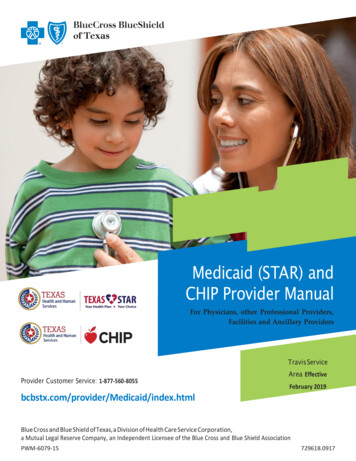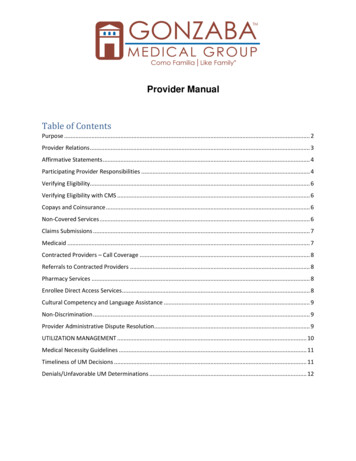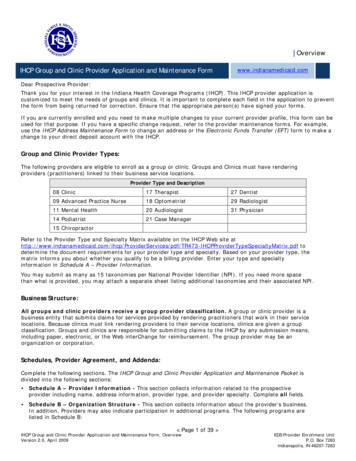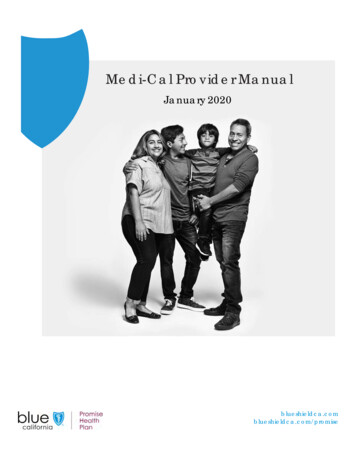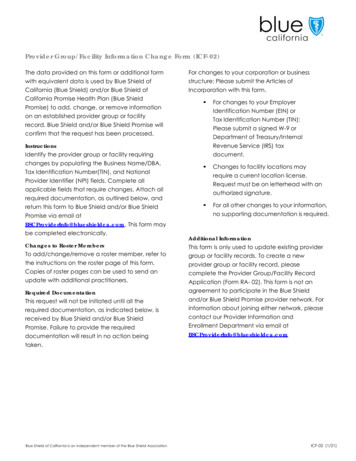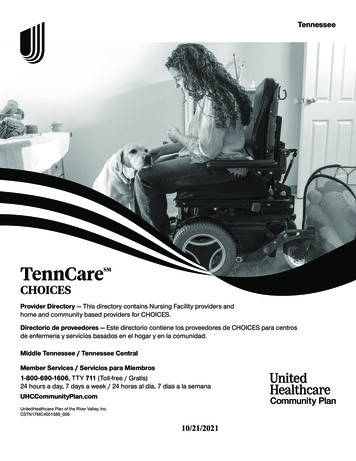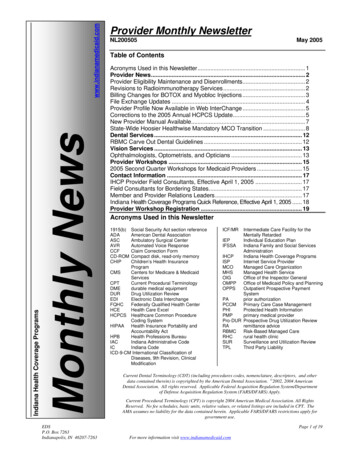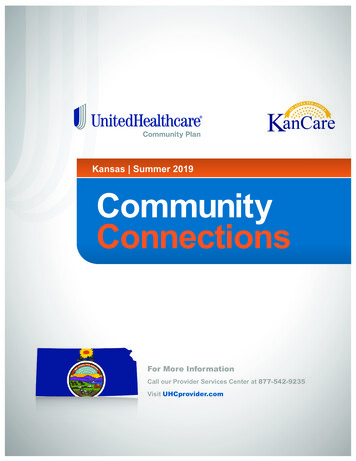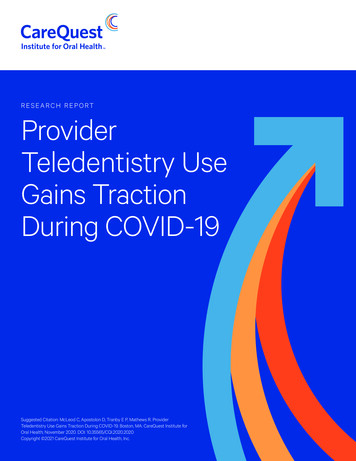
Transcription
RESEARCH REPORTProviderTeledentistry UseGains TractionDuring COVID-19Suggested Citation: McLeod C, Apostolon D, Tranby E P, Mathews R. ProviderTeledentistry Use Gains Traction During COVID-19. Boston, MA: CareQuest Institute forOral Health; November 2020. DOI: 10.35565/CQI.2020.2020Copyright 2021 CareQuest Institute for Oral Health, Inc.
AuthorsMethodologyCaroline McLeod, RDH, MSValue-Based Solutions ManagerCareQuest Institute for Oral HealthThe DentaQuest Partnership for Oral Health Advancementconducted this electronic survey from August 13 to September1, 2020, by sending an emailed invitation and link to a list of21,617 DentaQuest-enrolled dental providers in more than 20states. Up to three reminders were sent to prompt completion.Respondents were only asked to complete the entire surveyif they indicated having a high degree of familiarity with theirdental office’s patient volume, staffing, dental insurance carriers,treatment protocols, and the office’s pre- and post-COVIDfinances. A total of 2,767 dental providers partially or fullycompleted the survey, for a response rate of 13%, and 2,299passed the screening questions.Danielle Apostolon, BSTraining Specialist, Oral Health Value-Based CareCareQuest Institute for Oral HealthEric P. Tranby, PhDData and Impact Manager, Analytics and EvaluationCareQuest Institute for Oral HealthRebekah Mathews, MPADirector, Value-Based CareCareQuest Institute for Oral HealthAcknowledgmentsJulie Frantsve-Hawley, RDH, PhDDirector, Analytics and EvaluationCareQuest Institute for Oral HealthMadhuli Thakkar, BDS, MPHBiostatistician, Analytics and EvaluationCareQuest Institute for Oral HealthMatt Jacob, BAScientific Writer and Communication ConsultantCareQuest Institute for Oral HealthMatthew Allen, DDSPresidentM. David MI Inc.Vuong K. Diep, MPHHealth Science SpecialistCareQuest Institute for Oral HealthProvider Teledentistry Use Gains Traction During COVID-19carequest.org2
Use of TelehealthWith most providers open for comprehensive dental services, telehealthhas become a sustained means to provide safe, efficient and accessibledental care in a pandemic environment. A new survey shows growthpotential for telehealth as well as barriers to overcome in dentistry toprovide quality services while reducing the cost of care.Results from a recent survey conducted in August 2020 by theDentaQuest Partnership for Oral Health Advancement (DQP)show that nearly a quarter (23%) of dental providers are continuingto see patients via telehealth platforms. In addition, 11% of providerswho are not utilizing telehealth for patient care plan to use it in thenear future.The DQP survey was completed by 2,767 dental providers in morethan 20 states in August 2020. When DQP conducted a similarstudy in June 2020, many dental offices were closed or greatlyrestricted in the care that could be rendered. The June studyrevealed that 27% of providers were seeing patients via telehealthand 13% planned to do so in the near future. In June, dental officeswere limited to mostly providing urgent and nonelective services.By August, these practices were operating in a less restrictiveenvironment and provided more elective services. This stableuse of telehealth from June to August as offices were reopeningshows telehealth has “staying power” in dentistry.Provider Teledentistry Use Gains Traction During COVID-19Dental Practices that are seeing patients viatelehealth care or virtual platforms by state38%10%26%17%42%24%25%30%25%13%16%MD 12%22%31%14%24%12%7%23%22%35%Percentage of providers currently using telehealth or virtual platforms by state7%42%carequest.org3
Providers completing the August survey reported an averageof 9% of their patient visits were performed via telehealth theprior week. There is a statistically significant difference (p 0.001)in telehealth use by practice setting. Public health providersare more likely (44%) to use telehealth than all other practicetypes (21%). Additionally, there are differences in percentage ofproviders using telehealth based on location.In states such as Pennsylvania, Washington, Florida, Kentucky, andArizona, at least 30% of providers are using telehealth to providedental care (figure below). These differences may be due in part topayment and coverage policy variations among the states.The majority of providers use telehealth modalities thatprimarily allow for synchronous (“live”) communication: 60% of providers are using telephone calls 42% of providers are using a free virtual meetingsoftware (e.g. Facetime, Zoom, Google Meets, Skype,Microsoft Teams, etc.) 29% of providers are using a paid telehealthsoftware (e.g. Denteractive, Doxy.me, Luma Health,MouthWatch TeleDent, Teledentists, Virtual Dental Care)Telehealth modalitiesProviders were less likely to use telehealth to deliverpreventive services than they were to employ this technologyfor diagnostic and prescription services. This finding dovetailswith a report from the Centers for Medicare & MedicaidServices (CMS). The report revealed that delivery of any typeof health service through telehealth increased by over 2,500%from February to April during the pandemic. However, ratesfor preventive services, including oral health, performed inperson or via telehealth among children enrolled in Medicaidand the Children’s Health Insurance Program (CHIP) sharplydecreased during the same time period. These services arevital to the prevention of disease and promoting positivelong-term health outcomes for children covered throughthese programs.In addition, the majority of providers practicing withtelehealth used telephone calls; however, this modality(audio-only) is not reimbursed as commonly as othermodalities. It also cannot be used to prescribe (controlled)pain medication, which was the most highly provided service(along with antibiotic prescriptions). The Drug EnforcementAdministration mandates that audio-visual means must beused to provide a (controlled) pain medication prescription.1Telehealth dental services60%telephone calls72%prescribe antibioticsor medication for pain42%free virtual meeting software63%triage patientsto prioritize care29%paid telehealth software52%facilitatea referral48%visual exam38%COVID-19 prior to visitscreening38%evaluate for risk of disease37%oral hygiene instructionsThe need for alternative ways to receive dental care hasbeen amplified by the need to comply with social distancingguidelines. Telehealth can be used to provide patients with awide variety of dental services, but the August survey revealedthat some services are being provided more than others: 72% prescribe antibiotics or medication for pain 63% triage patients to prioritize care 52% facilitate a referral 48% visually examine the patients’ mouth/teeth 38% screen patients for COVID-19 symptoms priorto an office visit 38% evaluate patients for risk of disease 37% provide oral hygiene instructionsProvider Teledentistry Use Gains Traction During COVID-19carequest.org4
Opportunity for GrowthThe ongoing uncertainties around COVID-19 has led to theexpansion of telehealth usage. About 75% of providers whouse telehealth services expect their telehealth encountervolume to stay the same or increase during the next 12 months.Providers have mixed attitudes about when the pandemic willbe brought under control in their state, with 25% expecting itto be brought under control within 60 days and another 25%expecting it to take 2 years or more, were unsure, never expectit be brought under control, or expected control only whena vaccine is available. Once the pandemic has been broughtunder control, 62% of providers believe business will return tonormal in less than one year. This extended period of recoveryfrom COVID-19 necessitates the sustained use of telehealth toprovide safe, non-contact care to patients.Telehealth will be a long-term opportunity in dentistry andproviders should embrace it to deliver a variety of services,including prevention. As a white paper from DQP in March2020 explains, growth in the use of teledentistry brings manybenefits to patients and providers, including increased patientaccess to dental care, access to new patient populations,more efficient and safe triage of patient needs, potentialfor increased revenue, a more efficient referral process, andopportunities to improve oral health while reducing costs.Satisfaction with telehealth is also vital to building momentumfor this innovative model of care. Recent surveys show strongsatisfaction among patients and providers: Of the providers using telehealth, most (62%) are somewhator very satisfied with the technology they use to conducttelehealth encounters. In an April 2020 study by Advantage Dental by DentaQuestand the DentaQuest Partnership, researchers found thatmost (86%) of patients were satisfied with their overallteledentistry experience, and 93% reported being able“to easily understand what the dentist told me aboutmy concern.”Provider Teledentistry Use Gains Traction During COVID-19In March, CMS noted that “no federal approval is neededfor state Medicaid programs to reimburse providers forteledentistry services.” According to the Kaiser FamilyFoundation, many states have expanded Medicaid coveragefor teledental services.3 This enabled providers predominatelyserving patients enrolled in Medicaid to use telehealth as apart of their pandemic business model.Expanding the use of telehealth will require overcomingbarriers in dentistry. Obstacles include how state dentalpractice acts classify telehealth services, reimbursementdifferences by insurer, lack of clarity surrounding data security,and inequities in the availability of technology to all patientpopulations. In addition, 42% of providers in the surveyreported using a free, non-HIPAA compliant communicationplatform, which is permitted by the Office for Civil Rights forthe duration of the pandemic.2 However, reinstatement ofHIPAA requirements after the pandemic could deter theuse of teledentistry.75%of dental providers who usetelehealth services expect their telehealthencounter volume to stay the same orincrease during the next 12 monthscarequest.org5
Telehealth and the Futureof Dental Care FinancingAlthough dental offices had largely reopened by the time ofthe August survey, the results indicate that offices still facelogistical and financial challenges during the pandemic.Telehealth has been a helpful tool for dental providers to adaptto their uncertain environments: Providers who reported no change or more patientvolumes were significantly less likely to use telehealth(52% and 53%, respectively) as compared to thosereporting lesser volumes. Providers who expected long-term changes in dentistrybecause of COVID-19, (such as with infection control,patient volume, use of minimally invasive care, andoperational procedures) were more than 3 times as likelyto say they use telehealth currently or will do so in thefuture compared to those who do not expect anylong-term changes. Providers with more than half of patients enrolled inMedicaid were 39% more likely to use telehealth.Telehealth can reduce the cost of carethrough efficient and widespread deliveryof care and oral health education, whilealso enhancing the capacity of practicesto provide care for additional patients orexisting patients with more complex needs.The results also revealed that dental providers who use telehealthare 34% more familiar with alternative payment models (APMs)and are 45% more likely to have an increased interest in learningabout APMs than those who don’t use telehealth. With theexpected rise of value-based care and APMs in dentistry4,telehealth can be used as a tool to extend care in ways thatenhance the financial sustainability of dental practices. Telehealthcan reduce the cost of care through efficient and widespreaddelivery of care and oral health education, while also enhancingthe capacity of practices to provide care for additional patientsor existing patients with more complex needs. APMs should bedesigned in a way that incentivizes providers to use telehealth toprovide patient-centered, quality dental care.Dental providers who.reported no change ormore patient volumeswere about50%LESSLIKELYto use telehealthas compared to thosereporting lesser volumesexpected long-term changes indentistry because of COVID-19were more than3XASLIKELYto use telehealth currently or will doso in the future compared to thosewho don’t expect long-term changeProvider Teledentistry Use Gains Traction During COVID-19use telehealth services areMOREFAMILIAR34%45%MOREINTERESTEDin learning about APMs thanthose who don’t use telehealthcarequest.org6
Conclusions and Next StepsThe majority of dental providers surveyed are using telephonecall and free virtual meeting software to deliver dental carethrough telehealth. In addition, among these providers,telehealth is being utilized mostly to screen, triage, andprescribe medication, all of which are generally used to treaturgent dental needs. Conversely, preventive services werethe least likely to be offered to patients via telehealth. Thisrepresents an opportunity for more providers to use telehealthfor patient education and other person-centered, preventiveservices, rather than just for triaging urgent services.While this survey reveals providers’ positive attitudes aboutthe continued use and growth of telehealth to providedental services, COVID-19 has driven expansion of insurancecoverage and enabling regulatory policies. This has allowedswift adoption of telehealth for emergent services (e.g.,prescription writing) more than for preventive services. Asgrowth in telehealth utilization is projected, permanent policychanges are vital to allow for widespread reimbursement oftelehealth-enabled preventive services, minimally invasivecare and care coordination, as well as including allied dentalprofessionals as providers of these services.As growth in telehealth utilization isprojected, permanent policy changesare vital to allow for widespreadreimbursement of telehealth-enabledpreventive services, minimally invasivecare and care coordination, as well asincluding allied dental professionals asproviders of these services.The financial health of a dental practice and their use oftelehealth are related. Providers who experienced financialdisruption and expect long-term changes to dental practicefrom COVID-19 were more likely to use telehealth. Telehealthhas the potential to provide additional revenue whileenhancing dental care access for current and new patients. Inaddition, telehealth has the potential to offer cost-savings bydiverting patients from seeking more expensive care, such asfrom an emergency department.5 Achieving cost savings whileproviding quality care and maintaining patient satisfaction isa hallmark of value-based oral health care. As there is a shifttoward alternative-based payment models in dentistry, the useof telehealth as a value-based care tool will likely increase.Provider Teledentistry Use Gains Traction During COVID-19carequest.org7
References1. United States Drug Enforcement Administration. DEA’s response toCOVID-19. response-covid-19. March 20, 2020. Accessed November 4, 2020.2. Office for Civil Rights. Notification of enforcement discretion for telehealthremote communications during the COVID-19 nationwide public healthemergency. cement-discretion-telehealth/index.html. March 30, 2020. Accessed November 4, 2020.3. Kaiser Family Foundation. State efforts to expand medicaid coverage& access to telehealth in response to COVID-19. -to-telehealth-in-response-to-covid-19/. June 22, 2020.Accessed Novmber 4, 2020.4. Boynes, S, Nelson J, Diep V, et al. Understanding value in oral health:the oral health value-based care symposium. Journal of Public HealthDentistry. October 15, 2020;80(4):0022-4006. https://doi.org/10.1111/jphd.12402.5. Nord G, Rising KL, Band RA, Carr BG, Hollander JE. On demandsynchronous audio video telemedicine visits are cost effective.American Journal of Emergency Medicine. 018.08.017.Provider Teledentistry Use Gains Traction During COVID-19carequest.org8
CareQuest Institute for Oral HealthCareQuest Institute for Oral Health is a national nonprofitchampioning a more equitable future where every person canreach their full potential through excellent health. We do thisthrough our work in grantmaking, research, health improvementprograms, policy and advocacy and education as well as ourleadership in dental benefits, care delivery and innovationadvancements. We collaborate with thought leaders, health careproviders, patients and local, state and federal stakeholders, toaccelerate oral health care transformation and create a systemdesigned for everyone. To learn more, visit carequest.org.This report and others are available at carequest.org.
The DentaQuest Partnership for Oral Health Advancement conducted this electronic survey from August 13 to September 1, 2020, by sending an emailed invitation and link to a list of 21,617 DentaQuest-enrolled dental providers in more than 20 stat
